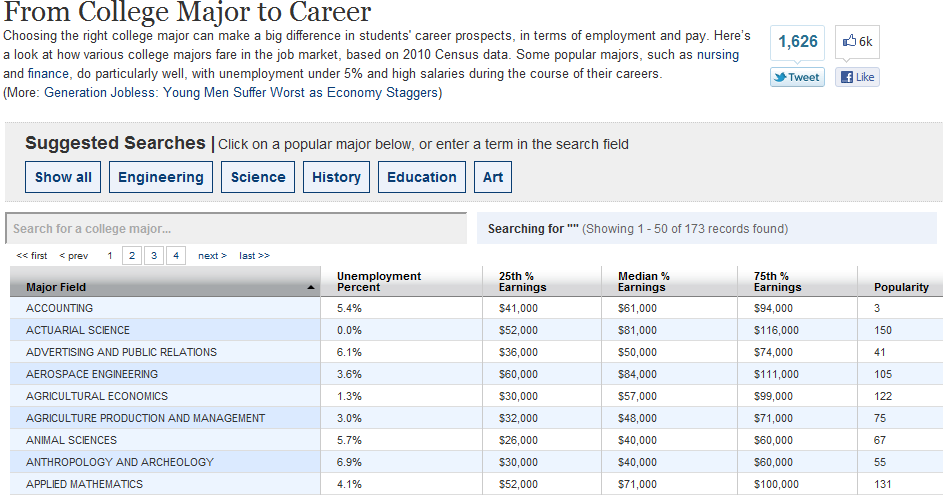I am a regular reader of Gabriel Rossman’s blog, Code and Culture. He posted an analysis yesterday (Nov. 7, 2011) featuring data from an interactive table published in The Wall Street Journal in a series entitled “Generation Jobless.” The interactive data table can be found as a sidebar to the main article called “From College Major to Career.”
Majored in what when?
Given the focus of the “Generation Jobless” series, I just assumed that this interactive table would depict recent grads. I was curious about the data used to create the table, so I decided to look into it a bit. As you can see from the description above the table, it is based on the 2010 Census. But then at the bottom of the table, the Georgetown Center on Education and the Workforce is cited as the source. I looked around at the Center’s website and I found what I think might be the WSJ’s source and it is a 2011 report called What It’s Worth: The Economic Value of College Majors by Anthony P. Carnevale, Jeff Struhl, and Michelle Melton. By scrolling to the bottom of the project page, I was able to find a methodological appendix that explains the data that they used in their analysis. They used the 2009 American Community Survey (ACS) which apparently for the first time ever “asked individuals who indicated that their degree was a bachelor’s degree or higher to supply their undergraduate major” (Page 1). If you read on in the appendix you see that “the majority of the analyses are based on persons aged 18-64 year old” and that “for the majority of the report we focus solely on persons who have not completed a graduate degree”. I looked back at the full report and I don’t see a table that has age categories or a subsection devoted to something like “recent grads”. It also turns out that this report received some press from both The Chronicle and InsideHigherEd when it was published back in May. Both of these pieces, which cite the director of the Center and one of the authors of the report, Anthony P. Carnevale, say that the data are from 25-64 year olds. So if the WSJ is using recent grads or an age category other than 25-64, I’m not sure if they’re getting it from this report (at least not directly). If the WSJ is using 25-64 year olds, you might be like me and this table might not mean what you think it means. That is, it might not capture how recent grads are faring in the job market these days. If it reflects all workers with bachelor’s degrees aged 25-64, you could be getting folks at all stages of their careers. For example, could these data include a 64 year old who majored in Finance, say, 40 years ago? Is their experience going to be the same as what is facing a member of “Generation Jobless”?
Again, I don’t know for sure how the WSJ used these data. Maybe someone else out there has had better luck finding out exactly how the folks at the WSJ have created this table?

Good questions!